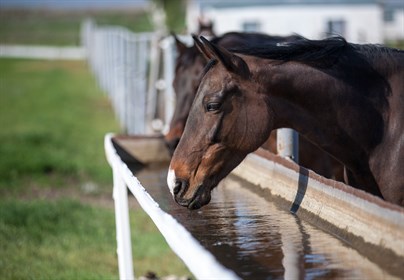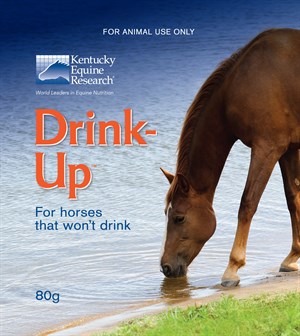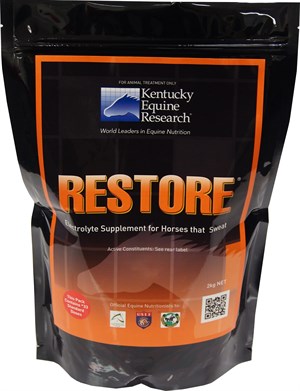|
#Sponsored

Winter is here and that means that there are some important management changes that may need to be considered for your horse’s health. As temperatures drop, equine vets often see an increase in the number of impaction colic cases. Ensuring that you are aware of the factors that contribute to this spike can help reduce the risk in your horse.
Horse owners have long known that any change in a horse’s management—travel, diet, exercise level, water intake, even the weather—can increase the risk of digestive upset. Change three or four things at once, and the risk for colic goes way up. That’s why it’s important to think about the changing season and take precautions to prevent problems before they show up.
Three factors that have a particular relationship to colic are exercise, diet, and water consumption. Colic is rare in horses that get plenty of exercise, are turned out to pasture where they can graze on fresh forage, and have plenty of fresh water available at all times. In some cases, these factors result in lower gut mobility, which can increase the risk of colic. Let’s explore these three factors in more detail.
Factors Affecting Water Intake During Cooler Weather
Changes in Exercise and Workload
During the winter months, it’s not uncommon for a horse’s ridden work to be reduced. However, some horses will be bought into stables with limited free exercise opportunities as well. Even horses that are still kept in paddocks may spend many hours in a paddock shelter, hiding from the wind.
For those horses who do remain in work, activity will increase the horse’s water requirement, with working horses potentially doubling their water requirement if they are sweating. When water sources are cooler and sometimes less appealing to horses, ensuring they are still consuming adequate water is important. If your horse is not clipped, and your horse is sweating, remember that sweat means electrolytes should be provided in your horse’s diet. Use a quality, well formulated electrolyte such as KER Restore which is designed to replace electrolytes in the same ratio in which they are lost.
Changes in Fibre Intake and Dietary Factors
We all know the importance that adequate roughage plays to ensure optimal gastrointestinal health and aim for around 1.5% of the horse’s body weight in roughage per day. It is normal for owners to provide supplementary hay during winter to assist with maintaining weight and body warmth.
In general, high fibre diets increase water consumption. However, the type of fibre being consumed is an important consideration. Fresh pasture is approximately 60–80% moisture, meaning horses obtain a substantial amount of water while grazing. However, during months when little pasture is available and the horse consumes more hay or chaff which contain far less moisture, horses need to drink more to meet their water needs. This can be particularly tricky in winter when the water temperature is cooler and some horses find it less appealing.
When horses consume large amounts of dry forage (with or without the addition of grain or concentrates which also have a relatively low moisture content), but inadequate water consumption, they have an increased risk of impaction colic. The stalkier the hay is, generally, the more indigestible it is, which can also contribute to an increased risk of colic in the absence of adequate water intake and saliva production.
Encouraging horses to drink water is critical. Dehydrated horses have trouble producing enough saliva to moisten ingested hay, and dry intestinal tissue doesn’t allow material to slide easily through the digestive tract. Horses prefer water that is not too cold; it doesn’t have to be warm, just at a moderate temperature.
Keep your horse’s teeth in good condition. Horses with sharp points or edges on their teeth will have trouble chewing hay. An equine dentist or veterinarian should examine your horse’s mouth once or twice a year, correcting problems and allowing the horse to eat more comfortably.

Changes in Water Consumption
We all know that water is the most essential nutrient and that horses cannot survive long without it. However, do you know how much your horse drinks? Horses normally consume between 20-55 litres of water in 24 hours, under normal conditions, depending on their physiological state. For an adult horse, in little to no work, the average is around 35 litres per day. When horses are not consuming adequate water, they can begin to show signs of impaction colic within 48 hours. This means that changes in a horse’s water intake need to be monitored and acted upon swiftly.
Hay, with its low moisture content and high amount of dry matter, replaces the horse’s grazing pattern of eating fresh grass more or less constantly. Be aware that horses need to drink more water when consuming forage in the form of hay or chaff in comparison to fresh, green pasture because of the difference in moisture content.
Water consumption may drop sharply if the water source is frozen or very cold. Even though we don’t have many large, snow covered fields like other parts of the world, water sources can still freeze – even if it is only a relatively thin layer on the top. Horses prefer water that is not too cold; it doesn’t have to be warm, just at a moderate temperature. When ingested material stops moving through the digestive tract, owners begin to see the signs of impaction colic.
It is important to note that certain metabolic conditions such as Cushings disease may also increase thirst. If there is no available water source that the horse is happy to consume, further problems may arise.
Management Strategies to Optimise Water Intake
Impaction colic can occur for a few reasons, however, during this time of year, a common reason is reduced water intake. Adequate water consumption is possibly the most important factor to prevent impaction. Owners need to be sure horses always have access to clean, fresh water that is not too cold. It is best to be armed with several strategies to get your horse to drink – before you need them!
Monitor Water Intake and Manure Production
Know your horse’s water intake! Check at least daily to ensure your horse has access to good quality, clean, fresh water. If your horse has access to an automatic water trough or natural water source such as a dam, monitoring intake can be tricky. In this instance, keep track of manure production. Very dry manure, or reduced manure production may be a sign that the horse is becoming dehydrated. If you notice any changes, contact your veterinarian.
Keep Water Sources Clean
If water is too dirty, unpalatable or foul smelling, horses may decrease their water intake – or cease altogether! If this is the only water source they have access to, this can quickly lead to dehydration and other health concerns such as colic. The growth of algae, or decomposing leaves in water troughs can make the water unpalatable for some horses to the point where water intake is affected. Keep water troughs and buckets as clean as possible. A water bucket that contains bits of manure, grain, or hay is not appealing to horses. Remember not to overlook automatic water systems as they too can become dirty and require regular cleaning.
Add Water to Hay and Feed
Feeding wet feeds and damp hay is a way to increase a horse’s water consumption, however, while this is useful as part of your overall plan, this will not provide adequate water intake alone.

Use Electrolytes and Supplements
The fact is that sometimes adding molasses to the water just doesn’t work and you need another plan.
Adding electrolytes, such as KER Restore, to a horse’s feed or water can be beneficial, but should be done with a degree of caution when horses are not drinking well. Providing the horse with electrolytes can cause further dehydration if adequate water is not also consumed. Electrolytes should always be provided alongside a clean, fresh water source which the horse can drink once the thirst response is activated.
Sometimes, you need a combination of water enticing strategies. KER Drink-Up is a scientifically formulated, complex combination of ingredients that work together to increase a horse’s willingness to drink. Research has shown that 90% of horses increased water intake with Drink-Up. Drink-Up uses multiple proven methods to entice horses to drink, rather than just relying to disguising the taste of the water. Smell is an important factor and leaving Drink-Up in the water for 20-30 minutes before offering it, further enhances this.
Drink-Up includes a small amount of KER Restore, an electrolyte to help further stimulate the thirst response. Drink-Up is a very economical and useful supplement to keep in your tack room, first-aid kit or float. Drink-Up is available in an individual 80g sachet and is the perfect solution to have at home or in the float ready for any occasion when your horse is not drinking.
Ensuring your horse drinks enough water when temperatures are cooler, can help to reduce the risk of impaction colic. Remember, your horse needs constant, adequate water intake. If you are concerned and not able to get your horse to drink, it is always best to contact your veterinarian.
If you have any questions about your horse’s diet, are concerned about water intake or have some equine nutrition questions you want answered, contact Kentucky Equine Research’s nutrition consultation service on 1800 772 198, email advice@ker.com or submit a diet analysis through our website www.ker.com
|

